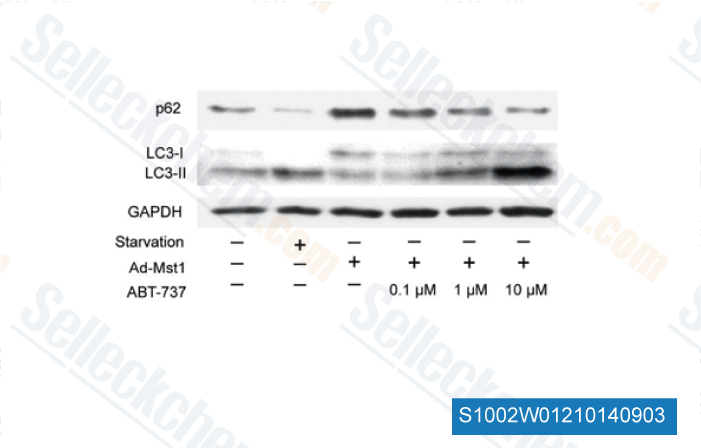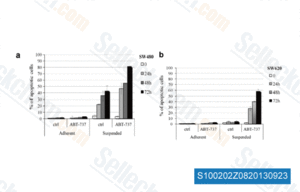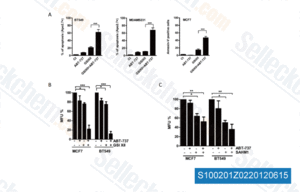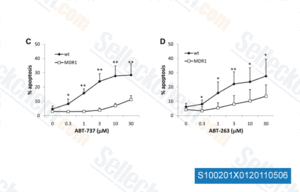|
Toll Free: (877) 796-6397 -- USA and Canada only -- |
Fax: +1-832-582-8590 Orders: +1-832-582-8158 |
Tech Support: +1-832-582-8158 Ext:3 Please provide your Order Number in the email. |
Technical Data
| Formula | C42H45ClN6O5S2 |
||||||
| Molecular Weight | 813.43 | CAS No. | 852808-04-9 | ||||
| Solubility (25°C)* | In vitro | DMSO | 100 mg/mL (122.93 mM) | ||||
| Water | Insoluble | ||||||
| Ethanol | Insoluble | ||||||
| In vivo (Add solvents to the product individually and in order) |
|
||||||
|
* <1 mg/ml means slightly soluble or insoluble. * Please note that Selleck tests the solubility of all compounds in-house, and the actual solubility may differ slightly from published values. This is normal and is due to slight batch-to-batch variations. * Room temperature shipping (Stability testing shows this product can be shipped without any cooling measures.) |
|||||||
Preparing Stock Solutions
Biological Activity
| Description | ABT-737 is a BH3 mimetic inhibitor of Bcl-xL, Bcl-2 and Bcl-w with EC50 of 78.7 nM, 30.3 nM and 197.8 nM in cell-free assays, respectively; no inhibition observed against Mcl-1, Bcl-B or Bfl-1. ABT-737 induces mitochondrial pathway apoptosis and mitophagy. Phase 2. | ||||||||
|---|---|---|---|---|---|---|---|---|---|
| Targets |
|
||||||||
| In vitro | ABT-737 shows low activity to Bcl-B and no effects to Mcl-1 and BFL-1. ABT-737 is sensitive to HL60, KG1 and NB4 cells with IC50 of 50 nM, 80 nM and 80 nM, respectively. ABT-737 induces apoptosis in HL60 cells, which due to decreased Bcl-2/Bax heterodimerization and has no effect on cell cycle distribution. ABT-737 also induces cytochrome c release from purified mitochondria and promotes conformational changes in Bax that are associated with apoptosis. [1] Resistant cells (Hela and MCF-7) can be sensitized to ABT-737 by approaches that down-regulate, destabilize, or inactivate Mcl-1. ABT-737 also causes Bax/BAK-dependent cytochrome c release only when Mcl-1 has been neutralized. [2] ABT-737 displaces Bim from Bcl2's BH3-binding pocket, allowing Bim to activate Bax, induce mitochondrial permeabilization, and rapidly commit the primary chronic lymphocytic leukemia (CLL) cells to death. [3] Knockdown of Mcl-1 with siRNA sensitizes two resistant SCLC cell lines H196 and DMS114 to ABT-737 by enhancing the induction of apoptosis. Likewise, up-regulation of Noxa sensitizes H196 cells to ABT-737. ABT-737 inhibits proliferation and induces apoptosis in many SCLC cell lines including NCI-H889, NCI-H1963, NCI-H1417, NCI-H146 and etc. Bcl-2 and Noxa may contribute mechanistically to the cellular response to ABT-737 in NCI-H146 cells. [4] A recent study shows that ABT-737 significantly induces apoptosis in HTLV-1 infected T-cell lines as well as in fresh ATLL cells. [5] | ||||||||
| In vivo | In aggressive leukemia model, ABT-737 suppresses the leukemia burden by 53% at the 30 mg/kg, with significantly extended survival of mice. ABT-737 does not induce significantly abnormalities in blood cell counts or serum chemistries. [1] ABT-737 prolongs the survival of recipient mice transplanted with Bcl-2-transduced tumors. [2] ABT-737 shows great antitumor activity in an ATLL mouse model at a dose of 100 mg/kg. [5] | ||||||||
| Features | First-generation inhibitor of anti-apoptotic Bcl-2 proteins. |
Protocol (from reference)
| Kinase Assay: |
|
|---|---|
| Cell Assay: |
|
| Animal Study: |
|
References
Customer Product Validation

-
Data from [Nat Med, 2013, 19(11), 1478-88]

-
Data from [Cell Death Dis, 2013, 4, e801]

-
Data from [Biochem Biophys Res Commun, 2013, 408, 344-9]

-
Data from [Biochem Biophys Res Commun, 2012, 408, 344-9]
Selleck's ABT-737 has been cited by 378 publications
| Dual Inhibition of CDK4/6 and XPO1 Induces Senescence With Acquired Vulnerability to CRBN-Based PROTAC Drugs [ Gastroenterology, 2024, S0016-5085(24)00062-3] | PubMed: 38262581 |
| Mitophagy curtails cytosolic mtDNA-dependent activation of cGAS/STING inflammation during aging [ Nat Commun, 2024, 15(1):830] | PubMed: 38280852 |
| Detection of senescence using machine learning algorithms based on nuclear features [ Nat Commun, 2024, 15(1):1041] | PubMed: 38310113 |
| BH3 mimetics and azacitidine show synergistic effects on juvenile myelomonocytic leukemia [ Leukemia, 2024, 38(1):136-148] | PubMed: 37945692 |
| Inhibitor PF-04691502 works as a senolytic to regulate cellular senescence [ Exp Gerontol, 2024, 186:112359] | PubMed: 38184267 |
| Tau activation of microglial cGAS-IFN reduces MEF2C-mediated cognitive resilience [ Nat Neurosci, 2023, 26(5):737-750] | PubMed: 37095396 |
| Intracellular FGF1 protects cells from apoptosis through direct interaction with p53 [ Cell Mol Life Sci, 2023, 80(10):311] | PubMed: 37783936 |
| STING agonism turns human T cells into interferon-producing cells but impedes their functionality [ EMBO Rep, 2023, e55536.] | PubMed: 36705069 |
| HPV-induced host epigenetic reprogramming is lost upon progression to high-grade cervical intraepithelial neoplasia [ Int J Cancer, 2023, 152(11):2321-2330] | PubMed: 36810770 |
| SARS-CoV-2 E and 3a Proteins Are Inducers of Pannexin Currents [ Cells, 2023, 12(11)1474] | PubMed: 37296595 |
RETURN POLICY
Selleck Chemical’s Unconditional Return Policy ensures a smooth online shopping experience for our customers. If you are in any way unsatisfied with your purchase, you may return any item(s) within 7 days of receiving it. In the event of product quality issues, either protocol related or product related problems, you may return any item(s) within 365 days from the original purchase date. Please follow the instructions below when returning products.
SHIPPING AND STORAGE
Selleck products are transported at room temperature. If you receive the product at room temperature, please rest assured, the Selleck Quality Inspection Department has conducted experiments to verify that the normal temperature placement of one month will not affect the biological activity of powder products. After collecting, please store the product according to the requirements described in the datasheet. Most Selleck products are stable under the recommended conditions.
NOT FOR HUMAN, VETERINARY DIAGNOSTIC OR THERAPEUTIC USE.
